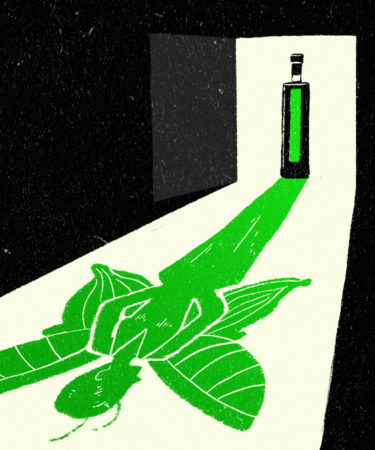Absinthe’s purported power to conjure fairies and send drinkers insane endures thanks to misrepresentations in art, literature, music, and movies — and loaded, pseudo-scientific experiments. In reality, painting the so-called “Green Fairy” as some kind of conscious-expanding elixir is the work of pure fiction, the effects of which have rippled for more than 100 years.
The truths can sometimes feel as cloudy as the liquor itself (when prepared properly), but there’s little need to worry about absinthe. To set the record straight, here are five of the biggest myths surrounding absinthe, busted.
Absinthe Makes You Hallucinate
Absinthe is a botanical distillate that contains, among other ingredients, a mixture of anise, fennel, and a type of wormwood called Artemisia absinthium. This wormwood imparts the psychoactive chemical thujone into the spirit. But the quantity of thujone present in modern absinthe is so little (a maximum of 10 parts per million in the U.S.), you’d sooner die of alcohol poisoning than be able to drink enough to start hallucinating.
But what about the past? Isn’t it possible that the absinthes being drunk during the Belle Epoque era had higher thujone levels? Scientists say no.
In 2008, international researchers from Germany, England, and the U.S. published a study comparing thujone levels from pre1915 absinthe with 20th-century and modern-day examples. The authors of the study note that the “thujone ranges of all absinthes are quite similar,” thus disproving any idea that absinthe historically contained higher levels of psychoactive chemicals and was therefore hallucinogenic.
Absinthe Turns People Crazy
Other than the myth that it makes drinkers see things, absinthe has gained notoriety for its supposed ability to drive people crazy. Once again, the science used to explain this phenomenon, called “absinthism,” is shaky at best and doesn’t hold up to modern scrutiny.
The links between absinthe and mental health issues are based on the experiments of Dr. Valentin Magnan, a French psychiatrist who strongly opposed absinthe and what he believed to be its ill effects on society.
During the late 19th century, Magnan carried out tests on animals using thujone and wormwood oil. He noted that when mice consumed high concentrations of thujone, they had convulsions and died. When Magnan gave a dog a vial of wormwood oil, he watched it bark at a brick wall for half an hour.
For years, Magnan’s findings went mostly unchallenged. Then in 2006, authors of the medical paper “Absinthism: a fictitious 19th century syndrome with present impact,” noted that “[t]he only consistent conclusion that can be drawn from those 19th century studies about absinthism is that wormwood oil but not absinthe is a potent agent to cause seizures.”
What’s more, the paper points out that there is no evidence absinthe is epileptogenic, nor that absinthism can be distinguished as a distinct syndrome from alcoholism. In other words, absinthe’s most harmful characteristic has always been its alcohol content, which typically ranges from 45 to 70 percent ABV.
Absinthe Is Illegal
This misconception is the only one tied to facts, as absinthe was illegal in many countries for most of the 20th century.
Numerous factors likely contributed to the Green Fairy’s banning across large parts of Europe and the U.S., including Magnan’s experiments. Then came the case of the Lanfray murders in Switzerland in 1905.
After spending a good portion of his day drinking, Swiss vineyard worker Jean Lanfray murdered his wife and two daughters in a drunken rage one night. Though Lanfray also drank Cognac, brandy, crème de menthe, wine, and beer that day, it was the two glasses of absinthe he drank that stirred more interest from the prosecutor and media.
Absinthe was quickly banned in Switzerland. And with the exception of England and Spain, absinthe was outlawed by most European countries and the U.S. by 1915. Stateside, it would remain illegal until 2007, by which point scientists had dispelled fears over the dangers of thujone.
Absinthe Requires a Flaming Sugar Cube
It’s easy to see why some confusion arises over how to drink absinthe, especially with ornate water fountains and silver spoons both common, useful accessories. Given the spirit’s potent strength, and just like other anise-flavored alcohols, absinthe is best enjoyed diluted with water. The perfect dilution ranges from brand to brand, but enough ice-cold water should be added to spark the “louche” effect, turning the spirit cloudy or milky, thanks to the emulsification of essential oils and water. (Three parts water to one part absinthe is a loose guideline.)
Historically, this water has been added drip-by-drip over a slotted spoon and single sugar cube — the sweetness helping to counteract the natural bitterness of wormwood. Where and how flames first figured into the equation is just as unclear as properly diluted absinthe. Needless to say, the practice persists purely for visual impact and perhaps only takes away from the experience.
Absinthe Can Only Be Made in Europe
Despite deep rooted ties to France and Switzerland, absinthe in general is not a geographically protected product. This means distillers in America are just as welcome to conjure the Green Fairy as those from mainland Europe — and more than a handful are.
In 2019, however, following 15 years of negotiations, the EU granted Protected Geographical Indication (PGI) status to Absinthe de Pontarlier. Just as only sparkling wine made in Champagne can bear the historic region’s name, the new labeling applies only to producers in the Swiss border region of eastern France.
The EU regulations also dictate all the major aspects of Absinthe de Pontarlier production, including ingredients and their provenance, alcohol content, and — of course — the quantity of thujone allowed in the spirit.
